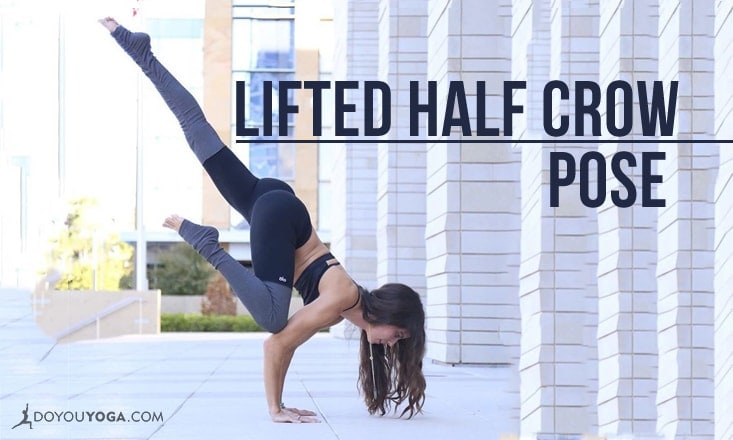If you are ready to challenge yourself physically and mentally, take a moment to get to know how to fly in Lifted Half Crow Pose. Known in Sanskrit as Eka Pada Bakasana I, Lifted Half Crow Pose or One Footed Crow Pose, is an advanced yoga posture that requires immense arm and core strength, hip flexibility, and concentration.
Benefits
Eka Pada Bakasana is an asymmetrical posture where the abdominal organs and muscles contract on the side with the bent knee, and the abdominal organs and muscles stretch on the side of the extend leg. The compression on one side massages the internal organs, which aids in digestion and cleaning. The asymmetrical nature improves coordination throughout the body and balances the nervous system.
In addition, Eka Pada Bakasana strengthens the chest, back, core, arm, and shoulder muscles. Specifically, the abdominal and pelvic floor muscles are recruited to lift the pelvis and keep the body as light as possible as the hip flexors engage to balance one knee gently on top of the supporting triceps muscle.
The back, hamstring, and glute muscles are employed to help lift the lengthened leg and maintain a long spine. A full-body workout, Eka Pada Bakasana requires focus and mindfulness to maintain the pose for the recommended 10-20 seconds. While it may feel unattainable in this lifetime, improved coordination, muscle strength, and focus never go out of style.
Step-by-Step Instructions
Traditionally taught from the tripod variation of Supported Headstand (Salamba Sirsasana):
- Slowly lower the legs to parallel to the floor
- Gently bend the right knee toward the right arm so the front of the knee meets the back of the supporting arm
- Exhale to simultaneously lift the trunk up (it will move back a little, try to keep everything engaged and to minimize the movement back) and raise the head off the floor to gaze softly forward
- Keep the body parallel in this variation and be mindful to not rest any of the body on the left arm
- Fully extend the spine long, lengthening from top of the head through the extended left toes and hold for 10-20 seconds
- Gently return to headstand and repeat on the left side
Contemporary teaching from Crow Pose (Kakasana):
- Slowly contract the right side of the body and shift more weight into the right knee and arm
- Scoop the navel toward the spine and maintain length through the body as the left leg lifts off the left arm
- Practice balancing with both knees hugging toward the right leg, then gently bring the left knee floating to center
- Reach the head slightly forward as the left leg stretches back to help maintain balance and even weight distribution
- Hold for 10-20 seconds before returning to Crow and repeating on the left side
Preparatory Poses and Modifications
Crow-to-Headstand Balance Lifts
One of the scariest things about arm balances is the fear of falling. Specifically, for Lifted Half Crow Pose, it is also incredibly hard to lift the body off the ground from headstand to Crow.
One fun balance play exercise is to start in Crow and gently lower to Tripod Headstand with Crow legs, and then lift back to Crow. Repeating this lowering and lifting action 2-5 times without letting the feet touch the floor in-between rounds is a sure-fire way to activate the core and back muscles necessary to fly in Eka Pada Bakasana I.
Side Crow
Since this pose is all about balancing increased weight on one side of the body in Crow Pose, practicing Side Crow is a great way to increase body awareness and build general strength needed for Lifted Half Crow Pose.
General Core Exercises
Flying in Lifted Half Crow Pose requires activation of the core and back muscles. Practicing exercises like Boat Pose (Navasana) or Knee-to-Chest Plank Holds are great prep poses.
Hip Stretches
Tight hips can make it impossible for one leg to stay bent by the leg while the other extends, practicing Pigeon Pose (Eka Pada Rajakapotasana) and Figure 4 Stretch can help loosen tight hips and make this pose more accessible. In addition, finding a yogi squat (Malasana) with Crow arms helps the body’s muscle memory for Crow pose and stretches the hips and back.
How to Use Blocks in Lifted Half Crow Pose
Starting in Crow Pose arms with the hips lifted, a block can be used under the bent leg to help provide extra lift when learning to practice Eka Pada Bakasana I.
Warnings and Contraindications
As an advanced asana, this pose is likely to offer humility and patience into any practice. Without a strong back and core, this pose can be extremely heavy on the wrists. It is important for anyone with wrist injuries to be a little more cautious in this pose.
In addition, like with any arm balance and inversion, there is a chance of falling, so being mindful of the spinal alignment is also important.
Part arm balance, part inversion, and all sorts of challenging, Lifted Half Crow Pose invites experimentation and play into any yoga practice. Please feel free to comment below with any questions or tips!
Image credit: Andrea Taylor








